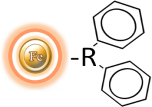
Hydrophobic interaction chromatography (HIC) is a technique for separating macromolecules from one another based on a reversible interaction between the external hydrophobic region of a biological macromolecule and the hydrophobic ligand (such as phenyl, octyl, or butyl) of a HIC medium. The interaction is enhanced by a buffer with a high salt concentration and reduced with a low salt concentration. Therefore, based on salt concentration in a buffer, the protein with less hydrophobicity is eluted first, whereas the protein with more hydrophobicity elutes last. Compared with other chromatography methods, HIC is a more popular method for separating and purifying protein and peptides in analytical and preparatory scale applications since it employs a less denaturing environment.
diPhenyl magnetic beads are highly uniform and superparamagnetic, featuring hydrophobic groups on their surface that make them effective as a chromatographic matrix. They enable manual or automatic purification, desalination, and concentration of peptides or proteins in the femtomolar to picomolar range, eliminating the need for repetitive pipetting and centrifugation procedures. BcMag™ diPhenyl Magnetic Beads are perfect for polypeptides with aromatic side chains, large, hydrophobic proteins, membrane-spanning peptides, lipid peptides, and fusion proteins from inclusion bodies. Choose between diPhenyl magnetic beads or BcMag™ diPhenyl Magnetic Beads for efficient and versatile protein purification.

Learn More
Instruction Manual
MSDS
Related Hydrophobic Magnetic Beads →


